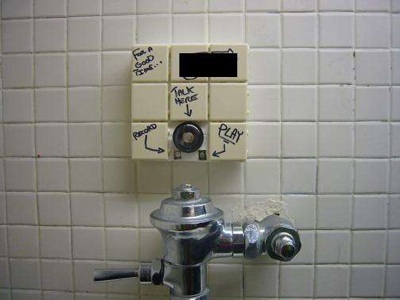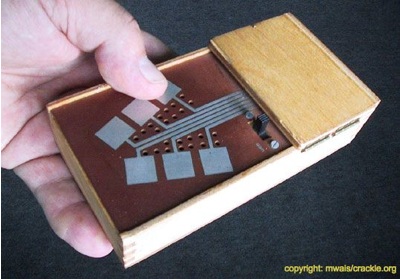High-tech graffiti is all the rage these days. Alongside various forms of LED graffiti and “photonbombing” with non-intrusive video projections, some artists are moving to the medium of sound. It’s not quite the same as the geniuses risking their lives to tag subway cars and long-forgotten tunnels, and it’s totally separated from the culture originally formed around graffiti, but in this post-modern age, I guess you take what you can get.
 Regine at We Make Money Not Art reports on two audio graffiti schemes presented at the Mobile Music workshop in Amsterdam. (There was a similar, mobile-themed event here in New York that I think actually fell roughly the same weekend — but I missed it! It’s a mobile meme.)
Regine at We Make Money Not Art reports on two audio graffiti schemes presented at the Mobile Music workshop in Amsterdam. (There was a similar, mobile-themed event here in New York that I think actually fell roughly the same weekend — but I missed it! It’s a mobile meme.)
The Audio Bombing scheme involves electronic “spray paint cans” reading from analog audio tape. Placing magnetic tape on walls and instruments is a technique popularized by Nam June Paik and later Laurie Anderson (Paik did installations, Anderson built instruments). It’s fascinating to watch old analog techniques making a resurgence.
Sonic Graffiti takes a related but distinct approach: not only do you use spray cans to “paint” and “play” sound, but the cans themselves employ a gestural interface so the participant can remix the sounds as they go. All of these projects play with the notion of place, so appropriately Sonic Graffiti geo-tags the sounds.
Both projects summed up here:
Musical graffiti [WMMNA, via Make]
I still wonder, though, if any of these objects have any meaning whatsoever, devoid of their original context. Boom boxes, graffiti, spray paint … but now as art events, at conferences, rather than part of an illegal subculture roaming the elevated trains and forbidden underground worlds of the Bronx? Something just doesn’t add up for me. The projects themselves are fascinating; would they be stronger or weaker if separated from these objects? Maybe selective graffiti via cleaning makes more sense. (Well, wait a minute — even that, is that so avant-garde? Hasn’t anyone seen trucks with “Wash Me” written on them?)
On the other hand, what these objects do successfully is provide props for people to understand what an otherwise abstract sound installation is about, because they’re icons with meaning. Curious to hear what people think on comments.

Instructables has a tutorial that lets you create your own sonic graffiti project. Here, finally, we have a solution to everyone’s apparent need to interact with strangers, time-delayed, in bathrooms (well, if that is what drives people to make graffiti). I wonder if anyone has actually installed and used one of these, and what they say?
audio bathroom graffitti box [Instructables, via graftag, who seems to follow digital music making + audio graffiti topics!]
Some of the other Mobile Music workshop, covered in detail on WMMNA, may be of still greater interest to CDM readers. Think pocket gamelans, paintings producing sound, performances on circuit-bent instruments and mobile phones as rock instruments, giant wearable speakers and mics and audio “guns”, and other wearable/portable instruments. The big story seems to be the renaissance of the Cracklebox, a self-contained, sound-making instrument with touch-sensitive input, originally created in 1974 and now finding its way into modern installations. Regine covers the whole event, so I’ll leave that to her.
